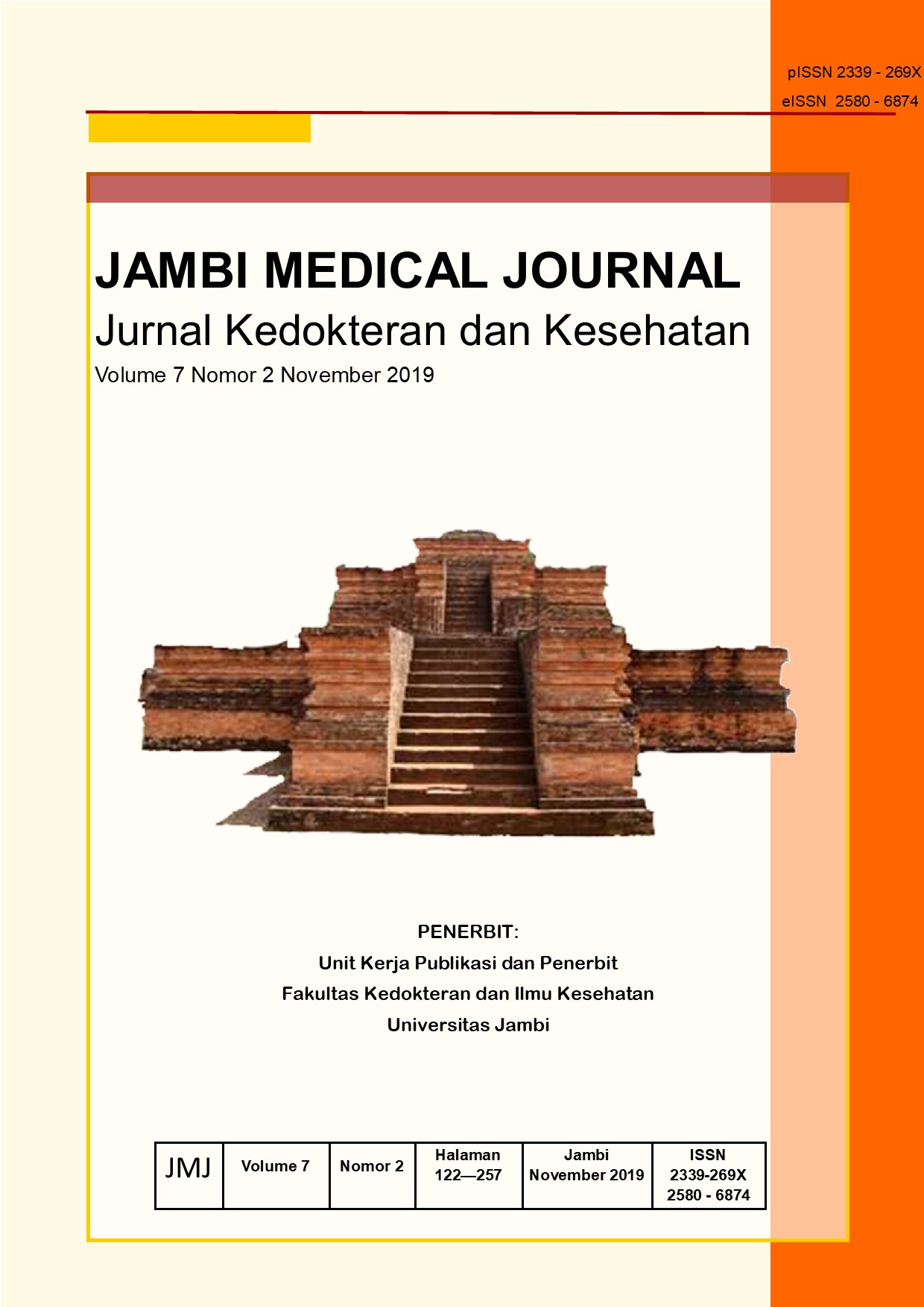HUBUNGAN KONSUMSI JENGKOL DENGAN KEJADIAN GAGAL GINJAL KRONIS DI BAGIAN PENYAKIT DALAM RSUD RADEN MATTAHER JAMBI TAHUN 2017
DOI:
https://doi.org/10.22437/jmj.v7i2.8014Abstract
ABSTRACT
Background: Djenkol (Pithecolobium jiringa) is one of the food consumed by the population of Indonesia. Djenkol seeds can be consumed raw, roasted, or fried. However djenkol contents djenkolic acid which nephrotoxic and can crystallize so it would blockage the urinary tract and then damaging the kidney. Chronic renal failure is chronic renal function impairment, progressive and irreversible. Chronic renal failure is a global health problem with an increased incidence, prevalence and morbidity rates. The purpose of this study was to determine the relationship of between consumption of djenkol with the incidence of chronic renal failure in the Department of Internal Medicine Raden Mattaher Hospital in Jambi from January to February 2017.
Methods: The observational analytic study with case control design held in 72 subject with 36 CRF patient in the case group and 36 non CRF patient in the control group. Purposive sampling was used to collect subject. This research was conducted at the Department of Internal Medicine Raden Mattaher Hospital in Jambi from January to February 2017. Data were obtained from interviews, medical records and observation sheet.
Results: In the case group dominated with male patient (20 respondents, 55,6%) and respondent with age range 36-45 years (11 respondent, 30,6%). Most of the respondents consume djenkol: 50 people (69.4%). In the case group who consume djenkol are 30 subjects (60.0%), while in the control group 20 subject consume djenkol. Chi-Square test showed that history consumption of djenkol associated with the incidence of CRF (OR = 4.000; p = 0.011; Cl95% = 1.337 to 11.965). The number of consume djenkol associated with the incidence of CRF (OR = 3.314; p = 0.023; Cl95% = 1.154 to 9.520). The frequency of consume djenkol associated with the incidence of CRF (OR = 3.750; p = 0.008; Cl95% = 1.379 to 10.200). The duration of consume djenkol associated with the incidence of CRF (OR = 3.143; p = 0.018; Cl95% = 1.199 to 8.241).
Conclusion: These results show that there is relationship between consumption of djenkol with the incidence of chronic kidney failure in the Department of Internal Medicine Raden Mattaher Hospital in Jambi from January to February 2017.
Keywords: chronic renal failure (CRF), consumption of djenkol, duration, frequency, number.
ABSTRAK
Latar Belakang : Jengkol (Pithecolobium jiringa) merupakan salah satu makanan yang banyak dikonsumsi oleh penduduk Indonesia. Biji jengkol dapat dikonsumsi dengan mentah, dibakar atau digoreng. Namun jengkol mengandung asam jengkolat yang bersifat nefrotoksik dan dapat mengkristal yang akan menyumbat saluran kemih dan merusak ginjal. Gagal ginjal kronik merupakan gangguan fungsi ginjal yang menahun bersifat progresif dan ireversibel. Gagal ginjal kronik merupakan masalah kesehatan dunia dengan peningkatan insidensi, prevalensi serta tingkat morbiditas. Tujuan penelitian ini adalah untuk mengetahui hubungan antara konsumsi jengkol dengan kejadian gagal ginjal kronik di Bagian Penyakit Dalam RSUD Raden Mattaher Jambi pada juli-agustus Tahun 2017.
Metode : Penelitian analitik observasional dengan desain case control dengan 72 sampel, diantaranya 36 pasien GGK sebagai kelompok kasus dan 36 pasien non GGK sebagai kelompok kontrol. Penelitian ini dilakukan di Bagian Penyakit Dalam RSUD Raden Mattaher Jambi periode Januari-Februari tahun 2017. Data diperoleh dari wawancara langsung, rekam medis dan lembar observasi.
Hasil : Pada kelompok kasus didominasi oleh pasien pria yaitu 20 orang (55,6%) dan responden dengan rentang usia 36-45 tahun (30,6%). Sebagian besar responden mengkonsumsi jengkol yaitu 50 orang (69,4%). Kelompok kasus yang mengkonsumsi jengkol ada 30 orang (60,0%), sedangkan kelompok kontrol yang mengkonsumsi jengkol ada 20 orang (40,0%). Pada uji statistic Chi-Square diperoleh riwayat konsumsi jengkol berhubungan dengan kejadian GGK (OR=4,000; p=0,011; Cl95%= 1,337-11,965). Jumlah konsumsi jengkol berhubungan dengan kejadian GGK (OR=3,314; p=0,023; Cl95%= 1,154-9,520). Frekuensi konsumsi jengkol berhubungan dengan kejadian GGK (OR=3,750; p=0,008; Cl95%= 1,379-10,200). Lama konsumsi jengkol berhubungan dengan kejadian GGK (OR=3,143; p=0,018; Cl95%= 1,199-8,241).
Kesimpulan: Dari hasil tersebut menunjukkan bahwa terdapat hubungan antara konsumsi jengkol dengan kejadian gagal ginjal kronik di Bagian Penyakit Dalam RSUD Raden Mattaher Jambi pada juli-agustus tahun 2017
Kata kunci: gagal ginjal kronik (GGK), konsumsi jengkol, lama konsumsi frekuensi, jumlah.












